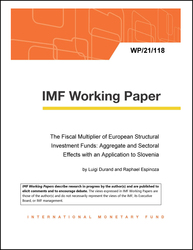
The Fiscal Multiplier of European Structural Investment Funds: Aggregate and Sectoral Effects with an Application to Slovenia
The Fiscal Multiplier of European Structural Investment Funds: Aggregate and Sectoral Effects with an Application to Slovenia
READ MORE...
Volume/Issue:
Volume 2021
Issue 118
Publication date: April 2021
ISBN: 9781513573762
$18.00
Add to Cart by clicking price of the language and format you'd like to purchase
Available Languages and Formats
| English |
Prices in red indicate formats that are not yet available but are forthcoming.
Topics covered in this book
This title contains information about the following subjects.
Click on a subject if you would like to see other titles with the same subjects.
Investments and Securities-General , Labor , Economics- Macroeconomics , Public Finance , Economics / General , Industries - Manufacturing , aggregate multiplier , sectoral multiplier , aggregate analysis , public investment , impact multiplier , Public investment spending , Private investment , Public employment , Manufacturing , Employment , Eastern Europe
Also of interest
Summary
In this paper, we estimate the aggregate and sectoral fiscal multipliers of EU Structural Investment (ESI) Funds and of public investment at the EU level. We complement these results with a specific application to the case of Slovenia. We first analyze aggregate data and find large and significant multipliers and strong crowding-in of private investment. Our main findings show that positive shocks to ESI Funds are followed by an increase in output that ranges from 1.2 percent on impact, to 1.8 percent after 1 year, and by an increase in private investment between 0.7 and 0.8 percent of GDP. We address country heterogeneity by dividing countries according to key characteristics that have been known to affect multipliers. In particular, we find higher multipliers in a group of CEE countries that are important recipients of European funds and are characterized by fixed exchange rate regimes and sound public investment governance (e.g. Croatia and Slovenia). We also complement the aggregate analysis by estimating the effect of different types of public investment and the effect of public investment on different sectors of the economy.
Copyright © 2010 - 2025
Powered by:
AIDC



